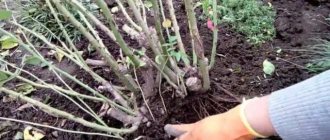Rooting methods
Rose shoots are planted using different methods. Some of them are truly unusual. The chances of rooting are approximately the same in all cases.
In water
Rooting stems in water is the most popular way to propagate purchased flowers from a bouquet. It requires a minimum of materials and time from the grower. Its disadvantage is that the stems sometimes rot in water. This is avoided with the help of special additives to the liquid.
Step-by-step instructions for planting pink cuttings in water:
- Pour 3-4 cm of liquid into the bottom of the container. To prevent rotting of the stems, add a little potassium permanganate (you should get a light pink solution), Glyokladin (according to the instructions) or Fitosporin (according to the instructions).
- Cover the container with the cutting with the top of a plastic bottle or bag and put it in a cool, bright place.
- Every day, the cuttings are ventilated for 15 minutes by removing the bag or unscrewing the cap at the top of the bottle. The stem is sprayed with settled water at room temperature.
- The water is changed every 2 days. It is not necessary to add disinfectants every time.
After 2 weeks, roots will begin to form. After this, the sprout is planted in the ground.
In the ground
You can also propagate roses from a bouquet in the ground. Before this, the bouquet must stand in water for 24 hours.
The soil is used purchased (special for roses and other flower plants) or prepared independently from equal parts of garden soil, sand and peat. The soil must be disinfected with a dark pink solution of potassium permanganate or calcined in the oven.
How to propagate a rose in the ground:
- The container is filled with soil and drainage. “Glyokladin” or “Fitosporin” is placed on the bottom. The soil is watered abundantly.
- The lower cut of the cutting is dipped into dry “Solution” or “Kornevin”. Then they stick it into the ground so that it stands without support.
- The top of the cutting is covered with a bag or a cut bottle. Every day the shoot is ventilated for 15 minutes.
- The seedling is placed on a southern windowsill and grown at room temperature. As the top layer of soil dries, the rose is watered with warm, settled water.
The formation of leaves and shoots indicates that the seedlings have taken root. After this, the duration of ventilation begins to increase. Then the greenhouse is dismantled.
In potatoes
One of the most unusual ways to grow roses is rooting them in potatoes. Its advantage is that the raw root vegetable contains a sufficient amount of moisture, as well as nutrients necessary for rooting of the cutting.
How to plant a rose in potatoes:
- Large potatoes are washed from the soil. They check that there are no traces of diseases and pests on it. All eyes are removed.
- Use a knife to make a small hole in the root vegetable. The cutting is stuck into it with the pointed part.
- The potatoes are placed in a deep container and covered with soil so that one pink bud is underground.
- Water the soil with warm sweet water (2 teaspoons of sugar per 1 cup of water). Then the containers with the cuttings are covered with film or a bag.
- Every day, the seedlings are ventilated for 15 minutes and sprayed with warm water from a spray bottle. Once every 5 days the soil is moistened.
When leaves and shoots begin to form on the rose, the duration of ventilation is increased. Then the greenhouse is removed and the plant is transplanted into the ground.
In the package
It is possible to germinate pink stems using only a bag and newspapers. This is another interesting way to propagate flowers from a bouquet:
- At the bottom of a large plastic bag, lay several layers of newspaper torn into pieces. Some gardeners prefer to use crumpled whole sheets.
- The newspaper is filled with water with the addition of “Fitosporin” and left until the liquid is absorbed. The inside of the bag is sprayed with water from a spray bottle.
- Prepared cuttings are dipped cut side into a dry root formation stimulator (“Kornevin”) and placed in newspaper.
- The bag is tied at the top and leaned against a support. This method is convenient for germinating a large number of cuttings.
- As the newspaper dries, moisten it with warm, sweet water. It is not the rose that is sprayed from the spray bottle, but the inside of the bag.
- The package is opened daily for 15 minutes for ventilation.
When the roots appear, the rose is transplanted into the ground.
Transfer
When the cuttings have stood in water for 1-2 days, and the pots of soil have already been prepared, begin planting. It has been noticed that spring and early summer are the best times for rooting roses from bouquets.
- Make a hole of a suitable size in the pot - only 1-2 upper buds are left on the surface, the rest of the cutting will be underground.
- The lower cut of the stem is dipped in dry fertilizer powder, Kornevin, for example.
- The cutting is lowered into the hole, covered with earth, and the surface is slightly compacted.
- Water at room temperature.
- Place a bag over the pot, having previously inserted spacers into the soil - wooden skewers or sushi sticks will do.
- The bottom of the bag is secured with a rubber band, creating a greenhouse effect.
The pots are placed in a cool place, the optimal mode is +18, +20°C. Lighting should be diffused, not too intense; direct sunlight should not be allowed. Spraying of the stem is carried out daily - in the first week up to 7 times a day, then gradually increased to 2-3 times. Every day, remove the bag for a few minutes to prevent waterlogging. When new leaves appear, the ventilation time is gradually increased, and when the plant gets stronger, it is removed completely.
How to grow a rose from a bouquet
You have a bouquet of roses. Did you know that you can grow a new plant from a cut flower? Would you like to learn how to grow a rose from a bouquet? To do this you will need a little effort and patience.
A folk way to grow a rose from a bouquet. passed from mouth to mouth is the following: cut the bud, leaves, make the cut at the bottom obliquely. Leave the remaining stem in water, it should give roots. When the roots are watered, simply transplant the rose into a pot. There is also an opinion that only roses with thorns give roots, and you don’t even have to try to root thornless roses, they won’t give roots.
You can grow a rose from a bouquet using a method such as cuttings. Cuttings with green leaves are cut from the rose stem. Cuttings will take root better if they are left with “heels”; they will produce roots faster. Using a sharp scalpel or razor, make a lower, oblique, even cut just under the kidney. If the cut is not smooth and the shoot is crumpled, the cutting may rot. The upper cut is the opposite - cut straight, no less than 1 cm above the buds. It is better to cut the cuttings into 2 internodes (with three buds).
But of course you can plant cuttings with one bud, and cuttings in one internode with two buds. They are just less likely to take root. Cut off the bottom leaf, and leave 2-3 leaves out of five at the top two so that less water evaporates. Did you cut it?
Now let's prepare the planting box or pots. Remember that they must be clean. If another plant previously grew in the pot, then perhaps some microbes remained. Be sure to treat them before planting a new plant. After all, the rose is a capricious and very whimsical flower; it is not for nothing that it received the name “queen” of flowers. Place drainage at the bottom of the pot, most often it is expanded clay, then add a layer of nutritious soil (a mixture of two parts turf soil, 1 part leaf soil and part sand). Carefully level the surface and cover it with river sand with a layer of 1.5 - 3 cm.
More details
I’ll share my experience: in December I was given a white rose that sprouted axillary buds. It was a shame to throw it away. I cut two cuttings from the stem, two buds on each. The bottom leaf and bud were removed, the cut was thickly dusted with Kornevin powder (an analogue of heteroauxin, a stimulator of root formation). I cut off the top third of an ordinary plastic bottle (1.5 liters), made holes in the bottom and poured expanded clay, then a substrate for indoor plants.
I stuck the cutting into the ground about halfway, so that the top leaf with the bud remained on the surface. I cut each of the three parts of the leaf in half, watered the soil well (it should not dry out) and covered it with the top of the bottle. Periodically I opened it to ventilate, and then I simply removed the cap of the bottle - and it turned out to be a small ventilation hole. The axillary buds soon withered away, one of the cuttings disappeared because... there was no old leaf on it. But the second one sat for a long time, and around February I saw white threads of roots below, in the soil! Sorry, I can't post a photo.
The dried axillary bud gave new two growth points and now the young shoots are about 10 centimeters. I did not remove the cover as long as the size of the sprouts allowed. When the shelter began to bother them, I removed it altogether. Of course, the winter sun is the winter sun - the sprouts are a little elongated and pale, so if possible, it is better to illuminate them. When young shoots appeared, the old leaf began to turn yellow - it had fulfilled its function. Here's how it worked out for me. When it gets warmer, I will plant this rose in the garden
I read somewhere that climbing roses grow best from cuttings (I gave my neighbors cuttings of my climbing roses and almost all of them took root successfully), but hybrid teas are short-lived, more susceptible to diseases and can fall off for no apparent reason after 3-4 years (tested), there Something is going on with their immunity, roses “from bouquets” especially suffer, it’s better to vaccinate them anyway
Harvesting rose cuttings in the fall.
Cut off in the fall, when preparing the bushes for winter, twigs of roses are suitable for propagation. Cuttings from them. immediately planted in cuttings, they successfully overwinter in the garden when protected from frost, and begin to grow in the spring.
More details
Useful tips
The article discussed how to properly plant a rose shoot. Experienced gardeners are well aware that there are some nuances on which its rooting in a pot or garden plot depends. Here are some of them:
- The role of drainage in pots and beds can be played by river sand or broken shells, which will not allow water to stagnate.
- If you really liked the roses in the bouquet and you want to get shoots from them, then you need to immediately begin the preparatory work: change the water in the vase every day, while it should be warm and settled, and at night place the bouquet in a basin of water with the heads down.
- Roses do not require large amounts of fertilizer. At first, organic ones will do. After the plant reaches 0.5-0.6 meters, you can feed it with mineral fertilizers.
- If the shoot is obtained from a bouquet and is well accepted, then it should not be left in the garden for the winter. Move it to a warm room or greenhouse.
- When harvesting cuttings, you do not need to tear off all the leaves, as the circulation of juice will be disrupted. Leave two or three leaves, shortening them by one third.
- In the first year of planting the plant, do not let it bloom. If buds appear, tear them off. Since first of all the root system must be formed.
And one more important point. The shoots from flowers in red or pink shades are good. The situation is worse with yellow roses. But white roses are the most problematic.
Now you know how to plant a domestic rose with a shoot.
What roses can grow in a vase with water?
Not every variety of roses sold in bouquets in a store will grow in a vase. Much depends on the conditions in which the flowers are kept. For example, specimens that have been in the store for a long time will never sprout.
Everyone knows that special preparations are added to the water to prolong the life of flowers. These additives negatively affect root formation. Sellers need fresh, beautiful bouquets to sell, not to propagate and replant.
It is easy to identify such flowers - the bottom is slightly blackened, and after a couple of days the stem begins to wrinkle. It is clear that such a rose will never take root.
And springtime promotes active vegetation. This also applies to the summer period - the chances of getting sprouts are greater.
Foreign varieties are treated with preparations that seem to preserve flowers, so that they fade more slowly and retain their beautiful appearance longer. The ability to root is reduced; such roses will not take root, even if there are young shoots.
It is important to remember that rooting roses that have sprouted in a vase with water is the most unreliable method of propagation. This is due to the fact that such roses, as a rule, are vaccinated with other varieties, for example, bush
This does not guarantee inheritance from the mother plant.
After cutting, they spend most of their energy on flowering; they no longer have enough energy to strengthen the shoots and roots.
The conclusion can be drawn as follows: it is possible to propagate a rose from a bouquet, but the process will be labor-intensive, and the result is not 100% guaranteed. We try to use domestic flowers that are not treated with drugs.
We are talking about the germination of a rose in a vase of water. Such roots differ from those formed in the soil. The root system becomes thinner, weaker, translucent and very fragile. The slightest fluctuation in moisture increases, and the process of rotting begins. When transplanting, the root system can be easily damaged, and it simply breaks when moving from water to soil.
Water contains a large amount of oxygen, so the following phenomenon is observed: the stem grows a strong root system in the vase, but after transplantation everything dies and does not take root. There’s nothing you can do about it, it all depends on the strength of the flower itself from which we sprout roots.
We hope that you will be able to propagate a bouquet rose the first time. These flowers will be a wonderful decoration among other indoor or garden plants.
Common mistakes
What to avoid:
- Attempts to increase the nutritional value of the soil for rooting with manure and other fertilizers. Mature plants really do need supplements. But cuttings from excess fertilizer can rot.
- High humidity does not mean that the rose will stand in liquid mud. If rooting occurs in the soil, it should be moist and not soaked in water.
- Abrupt transfer to the street or removal from greenhouse conditions. Young seedlings may not be able to cope with such changes. Acclimatization to the new environment should occur gradually.
Method number 2: planting in pots
Another way to plant roses from cuttings is to root directly into the soil. To do this, you need to prepare a suitable substrate in advance or purchase ready-made universal soil.
The soil mixture for roses consists of the following components:
- Two parts of ordinary garden soil. Before use, it must be treated with a disinfectant solution and calcined in the oven for disinfection.
- Two parts compost. You should definitely take rotted compost, or high-quality peat or leaf soil.
- One part sand. An ordinary oven is used, but also well washed and processed.
All components must be mixed, and for better drainage, a drainage layer must be installed at the bottom of the growing container. This can be fine gravel, expanded clay and even pieces of foam.
If the cut rose has sprouted, or rooting has occurred according to the method described above, you can plant the cuttings in previously prepared soil. To do this, make a hole in the soil using a pencil or stick, into which the sprout is carefully placed. The seedling is deepened to the level of the first bud and covered with earth. After this, it is recommended to slightly moisten the soil and cover with a cut plastic bottle or glass jar. This is done to provide the seedling with optimal conditions for growth.
After about two to three weeks, the cutting should be “hardened”, periodically removing the cover. This way the plant adapts better to external conditions. It is not recommended to keep the cuttings in “greenhouse” conditions for more than a month, otherwise the bush will hurt a lot in the future, and the chances of successful rooting will sharply decrease.
What conditions need to be created:
- The optimal temperature ranges from 25 degrees during the day and 18 at night.
- The place for seedlings should not be well lit so that the tender leaves do not burn. Also, do not place pots on drafty window sills.
- Watering is needed regularly, in small portions. Overmoistening is extremely undesirable and can lead to rotting of the roots.
- Humidity for seedlings needs to be high, but not excessive. There is no need to specifically spray the plants; greenhouse conditions will provide the required level.
Planting a rose under a jar is considered successful if a strong shoot appears on the stem. This usually happens within a month, but the cuttings are transplanted to a permanent place of growth only after strong shoots appear.
Increased chances of survival
The rose takes root in conditions of high humidity, so it is advisable to cover everything on top with a glass jar or plastic bag to increase the chances of survival of the cutting.
Experienced flower growers recommend not removing the jar until it is clearly visible that the rose has begun to grow (put out new shoots and leaves).
And only then can the “greenhouse” be opened slightly, gradually accustoming the young plant to the unusual dry air of the environment. The total duration of time from the moment the cutting is covered with a jar until the moment it is removed is about six months.
Optimal conditions for rooting cuttings
For rooting to be successful, you must try to create the most favorable conditions for the cuttings. There are not many requirements. Here are the three main ones:
- The optimal temperature is within + 25º. I think everything is clear with this point.
- Humidity 80 - 90%. Humidity is determined quite simply. Rose cuttings are grown under film cover or under jars; if the film is foggy from the inside, then the humidity is normal; if it is dry, it’s time to water.
- Neutral, poor soil. The easiest option when growing roses in open ground is to mix soil with sand in a 1:1 ratio. Just don’t try to add manure or compost. These adult roses love manure fertilizers, and cuttings from such additives can rot. In winter, cuttings can be carried out in peat, in peat mixed with sand, in perlite, vermiculite (vermiculite is preferable), in coconut fiber, or, as in summer, in soil with sand. In addition, you can use sphagnum moss.
You've probably heard other tips and tricks that should have a positive impact on the outcome of your case, but in practice, most of them either have minimal impact or are completely useless. I mean the following tips:
“You need to cut the leaves by half or 1/3.” This action does not affect the germination of roots in any way, you can cut it, you can leave it whole. The only thing you need to know and follow is that when cuttings in the light, leaves are needed, and when germinating in the dark (for example, using the buritto method), the leaves need to be cut off. Sometimes I cut plants in an aquarium and shorten the leaves there so that they don’t puff up, but this is only to save space.
It is convenient to carry out cuttings in an old aquarium.
“Use Kornevin or some other root-forming preparation” I repeatedly conducted unplanned experiments, dusted one batch of cuttings with Kornevin, and simply forgot to do it on the other. Thus, I had the opportunity to make sure that these preparations do not have any noticeable, positive effect on growing roses from cuttings (may the manufacturers of these powders forgive me).
“Deep the cutting into the ground 1 - 1.5 cm.” In my opinion, shoots buried 5 - 7 cm take root, if not better, then at least no worse, but working with them is much easier. Chibouks stuck 1 cm into the ground fall off with the lightest touch
Especially if their spines are not cut, which tend to get caught on everything.
“Make the lower cut at an angle of 45º, and the upper one at an angle of 90º.” Make the lower cut immediately under the bud, always with a sharp tool, and at what angle it will be made is absolutely not important. It is recommended to make the lower cut at an angle of 45º to increase the cutting area
It is at this place that callus then forms, and people probably think that the larger the area of the callus, the more roots it will grow. The most important thing is that the callus simply forms, and the roots will grow, you can be sure
It is recommended to make the lower cut at an angle of 45º to increase the cutting area. It is at this place that callus then forms, and people probably think that the larger the area of the callus, the more roots it will grow. The most important thing is that the callus simply forms, and the roots will grow, you can be sure.
But to increase the number of roots, I can recommend a more effective method. Callus, and then roots, appear on the injured parts of the stem, so several small wounds can be made on the part of the shoot that will be in the ground.
I usually remove all the thorns on the cuttings. On the above-ground part I cut it off with pruning shears, and on the part that will be in the ground I break it down to the base and a wound is formed in this place. Roots almost always grow from these wounds.
Callus formed in place of the broken spines.
The photo, unfortunately, is not of high quality, but I think it is clear that in place of the broken thorn an impressive callus has formed, from which roots will soon appear. I grew these cuttings in perlite, so they are so clean and everything is clearly visible.
Now let's talk about the most important thing: how can we learn to grow roses from presented bouquets?
The thing is that bouquets of roses are given throughout the year. And cuttings of roses in summer and winter, for obvious reasons, are very different. Therefore, each option will have to be considered separately, that is, seasonally.
Advantages of cuttings obtained independently
How to plant rose cuttings to get a beautiful flowering bush? If you liked the flowers growing in a friend’s garden and you decided to give yourself a gift - to grow similar ones on your own plot, then there is a chance of getting a good result. Self-produced shoots have significant advantages over purchased plants. What are they:
- By taking a cutting from a plant you like, you will know exactly what kind of rose will grow on your site.
- If you put in a little effort to get a cutting, you won't have to incur the expense of purchasing a plant.
- The shoot is more likely to take root than a purchased plant. This is due to the fact that when roses are produced en masse from cuttings, planting is carried out in special soils with a large amount of chemical fertilizers. Therefore, it is not a fact that a rose will take root well in ordinary soil and will not get sick.
Therefore, it is best to try growing a flower yourself. How to take a shoot from a rose correctly and what is the best time to do it? Let's try to figure this out.
Planting rose cuttings in autumn
Everyone knows perfectly well that rooted plants need to be planted in open ground in the spring and summer. It happens that harvested cuttings appeared long before the favorable planting time. How to preserve a rooted plant until the appointed time?
Cuttings are prepared for storage. All shoots from the cuttings are removed and treated with a growth inhibitor.
To treat the cuttings, use paraffin; this is a good way to slow down the growth of shoots. Paraffin is melted in a water bath, the upper part of the cutting is dipped and immediately immersed in water. This procedure can be repeated several times. Two or three layers of paraffin will reliably preserve the plant.
- The simplest and most relevant way to store cuttings is by digging them in open ground. This method is suitable for regions with mild climates. The cuttings can easily withstand a slight drop in temperature to 4-5 degrees. A trench is dug on the site, the dimensions depend on the amount of planting material, about 25 cm deep. The bottom is lined with straw or agrospan. We place the prepared cuttings on the insulation and cover the top with a layer of straw or insulation. Only now can you start filling it with earth. Leave small gaps between the cuttings; a tight fit can cause damage to the cutting.
- The basement and cellar will do an excellent job of preserving cuttings until spring. The cuttings are treated with paraffin and tied in several pieces. They are placed in boxes with sand and carefully covered with it. Good and long-term storage is guaranteed if the temperature is maintained at a cool temperature.
- If there is no cellar or basement, you can put the prepared cuttings for long-term storage in the refrigerator. The upper part of the cuttings must be treated with paraffin. The lower sections need to be provided with a constant moist environment. Use moss as a nutrient substrate. Cuttings of the cuttings are wrapped in damp moss and all this is neatly placed in a plastic bag. The bottom shelf of the refrigerator maintains the required cool temperature. Moss dries out over time, so you need to occasionally take out the bag and moisten it.
- Once you decide on a planting location, start preparing the soil.
- The ground for planting must be carefully dug up and stones and debris removed from it.
- Ash and eggshells are perfect as fertilizer.
- A shallow planting hole is dug, depending on the size of the root system.
- The excavated soil is mixed with ash and eggshells.
- The cutting is lowered into the hole and gradually covered with soil from different sides.
- The plant is watered and the soil around the bush is slightly loosened to create oxygen access to the root system.
- By following the correct planting technology, you can soon see the appearance of young shoots.
Autumn planting of rose cuttings from a bouquet is possible provided the winter climate is mild. Favorable time for planting is October, but no later than November 10-15.
- Prepare the cuttings and dip the lower cut into the root compound.
- The planting hole should not be more than 30 cm in diameter; if desired, planting can be done in trenches.
- Cuttings should be planted at a cutting angle; one or two buds may remain above the surface.
- The plant is watered and mulched with straw.
- To prevent freezing, cover the cuttings with jars or cut plastic bottles. The jars may be cracked or damaged. Several cuts must be made in the plastic. Air circulation is necessary for plant development.
- Cans and bottles are covered with insulation or covered with a thick layer of straw.
In other regions, rose cuttings can be planted in pots in the fall.
You can use one large container to plant several cuttings.
- To ensure greater safety in winter, the upper part of the cutting is treated with paraffin.
- Cover the bottom of the slide with a small layer of drainage made of expanded clay or broken ceramic dishes.
- You can use a ready-made soil mixture as soil, or take garden soil and mix it with perlite.
- The soil for planting should be slightly moist. Prepare holes for cuttings.
- The cuttings are dipped in the growth stimulator with the lower cut and placed 4-5 cm into the soil holes.
- The container must be wrapped in film or wrapped in cellophane. Wrap in a blanket or insulation and place in a cool place.
Avoid sudden drops in temperature as this can kill the plants.
Knowing all the subtleties and nuances of planting, you can safely start growing roses from a bouquet, regardless of the time of year and weather conditions. Don't be afraid to experiment, follow these tips and grow lush, stunning rose gardens.
The best time to work
In order for the process of cutting roses from a bouquet to bring the best results, it is better to carry out all procedures in late spring, summer, and autumn. The best root growth occurs in June. August-September is the time when the flowers become less vigorous, which negatively affects the growth of the root system.
The rose in the vase gave leaves
At other times, the rooting process will not proceed well. The most unfavorable period is January-February. Most likely, the results of a novice gardener at this time will be negative. In winter, it is necessary to provide the flowers with optimal illumination, temperature, and humidity.
What flowers can germinate?
Roses that have been in the store for a long time will never germinate: they often add drugs to the water that prolong the life cycle of the plant, but negatively affect root formation. As a rule, in such cases, the bottom of the shoot turns black, or the entire stem wrinkles slightly. Such flowers will never take root. Flowers purchased on March 8 are more likely to take root: they do not sit on the store counter, and spring only promotes active growing season, just like summer.
It should also be noted right away: roots can appear on the stem of almost any rose, but this is not a guarantee that you will be able to get a new plant, especially when it comes to Dutch hybrids. Most varieties imported from abroad are treated with special preparations that slow down the process of plant withering, but at the same time reduce its ability to take root. Therefore, roses grown in local conditions are most likely to take root (and later take root) in a vase.
Important! Rooting sprouts sprouted in a vase is a very unreliable method of propagation. The fact is that most purchased roses are usually grafted onto other varieties of rose bushes, and this does not guarantee 100% inheritance of the characteristics of the mother plant
The resulting rose will also be guaranteed to have problems with frost resistance. In addition, cut plants have already spent a lot of energy on flowering, so often roses that seem to be starting to sprout roots simply die when planted in the ground.
- It is believed that roots are more likely to appear on those stems that are placed in a vase made of opaque materials (preferably dark glass).
- The water in the container does not change, but is only added as it evaporates. You can first throw an activated carbon tablet into it.
- The water must be boiled or melted, since pathogenic microbes are present in large doses in raw water.
- The level of water in the vase is also important: if there is too much of it, the stem will most likely rot, since there will not be enough oxygen in the container (roots form at the boundary of water and air).
- The stem of a rose must have leaves: according to experienced gardeners, it is the leaves that produce a substance similar to a biostimulator of root formation, for example, heteroauxin. However, the leaves should not be immersed in water, otherwise they can provoke putrefactive processes.
- Naturally, the room where the bouquet is located should be light and warm enough (+20C – +24C).
This is interesting: Rose Chippendale - we study in detail
Planting cuttings in the ground and caring for them
To successfully plant prepared cuttings, the main thing is to select the soil, provide the necessary microclimate and water correctly. One of the differences when rooting from a bouquet is due to the fact that it can be carried out not only in summer, but also in winter, although with less survival rate. In this case, future bushes, naturally, must be kept in a warm room, in boxes or flowerpots.
The soil should be loose, contain enough air and retain moisture well. A slightly alkaline soil reaction is allowed, but neutral is best. Acidic soil is not suitable for roses. Pure coarse sand works well, but it is advisable to enrich it with nutrients by mixing it with garden soil, peat, and sawdust. Special soil for roses can be purchased at the store, especially if the future bushes are intended not for a flower bed, but for a flowerpot. You can root cuttings in boxes, providing a drainage layer under the soil.
Cuttings planted in the soil must be covered to create a mini-greenhouse for them with a certain microclimate - a temperature of 20 - 26 ° C and a humidity of 85 - 90%. In order not to deprive the cuttings of sunlight (after all, it’s not for nothing that we left them two green leaves for photosynthesis), use glass jars or cut-off plastic bottles, or set up a greenhouse under a film. The bottle can be cut off at the bottom and placed with the neck up so that you can water through it. If there is no shelter, water is poured from outside, trying to maintain consistently moderate soil moisture. Accumulating moisture on the inner surface of the bottle indicates that watering is not required yet. Air humidity is provided by daily spraying.
It should be borne in mind that even with ideal care, the survival rate of cuttings cannot be one hundred percent; in the best case, 8 cuttings out of a dozen planted take root. Some cuttings, without forming roots, develop at the expense of nutritional reserves. At first, they appear to be quite prosperous, but then they suddenly stop developing and die. This is the natural order of things, depending on the varietal characteristics; you should not be upset and expect more.
With the start of shoot growth from the upper bud, about a month after planting, the plant begins to be hardened, accustoming it to the open air. The greenhouse is opened slightly for a few minutes every day, increasing the duration of the procedure every day.
With proper care of the cuttings, in 2 months or a little earlier they will form roots. Buds may appear, but in the first, and even in the second, year this is harmful to the development of the plant, they need to be removed. In the third year after planting, the rose bush you grew from a bouquet is ready for full flowering.











